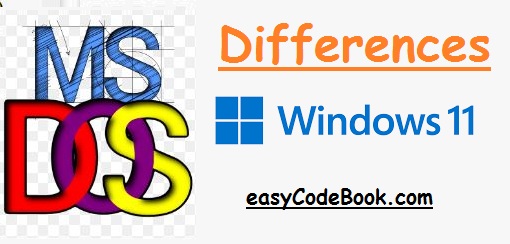DOS (Disk Operating System) and Windows are both operating systems, but they are quite different in terms of their history, functionality, user interfaces, and capabilities.

Here are the key differences between DOS and Windows:
- User Interface:
- DOS: DOS primarily uses a command-line interface (CLI) where users need to type text-based commands to perform tasks. It lacks a graphical user interface (GUI) by default, although some graphical shells and applications were developed for it later.
- Windows: Windows is known for its graphical user interface. It provides a visual desktop environment with windows, icons, menus, and a pointing device (typically a mouse) for user interaction. Windows GUI has become a standard in modern computing.
- Multitasking:
- DOS: DOS is a single-tasking operating system, meaning it can only run one program at a time. You have to exit one program before starting another.
- Windows: Windows is a multitasking operating system, allowing users to run multiple applications simultaneously. It manages resources and CPU time among various running programs.
- File System:
- DOS: DOS typically uses the FAT (File Allocation Table) file system. It lacks advanced file security features and long filename support.
- Windows: Windows supports various file systems, including FAT, NTFS (New Technology File System), and exFAT. NTFS, in particular, offers advanced file permissions, encryption, and support for long file names.
- Software Compatibility:
- DOS: DOS software is often limited to text-based applications and games. Older versions of Windows (such as Windows 3.1) could run some DOS applications in a virtual DOS environment.
- Windows: Windows supports a wide range of software, including graphical applications, productivity software, multimedia, games, and more. It has a broader software ecosystem compared to DOS.
- Hardware Support:
- DOS: DOS was originally designed for early PCs and has limited hardware support compared to modern operating systems.
- Windows: Windows has extensive hardware support, including drivers for a wide variety of hardware components, making it compatible with a broader range of devices.
- Networking:
- DOS: Networking capabilities in DOS were limited and often required third-party software or add-on cards for networking.
- Windows: Windows has built-in networking capabilities, making it easier to connect to networks, the internet, and share resources with other computers.
- Security:
- DOS: DOS lacks modern security features and user account management. It does not provide user-level access control.
- Windows: Windows includes various security features, such as user accounts with different privilege levels, access control lists (ACLs), and encryption options to protect user data.
- Evolution:
- DOS: DOS was developed by Microsoft in the early 1980s and went through several versions, with MS-DOS being one of the most well-known. It is no longer actively developed.
- Windows: Windows has evolved significantly since its inception in the mid-1980s. There are multiple versions and editions of Windows, with ongoing development and updates.
In summary, DOS and Windows are distinct operating systems with different interfaces, capabilities, and historical contexts. While DOS played a crucial role in the early days of personal computing, Windows has become the dominant operating system for modern PCs due to its user-friendly GUI, multitasking capabilities, and extensive software and hardware support.
![]()